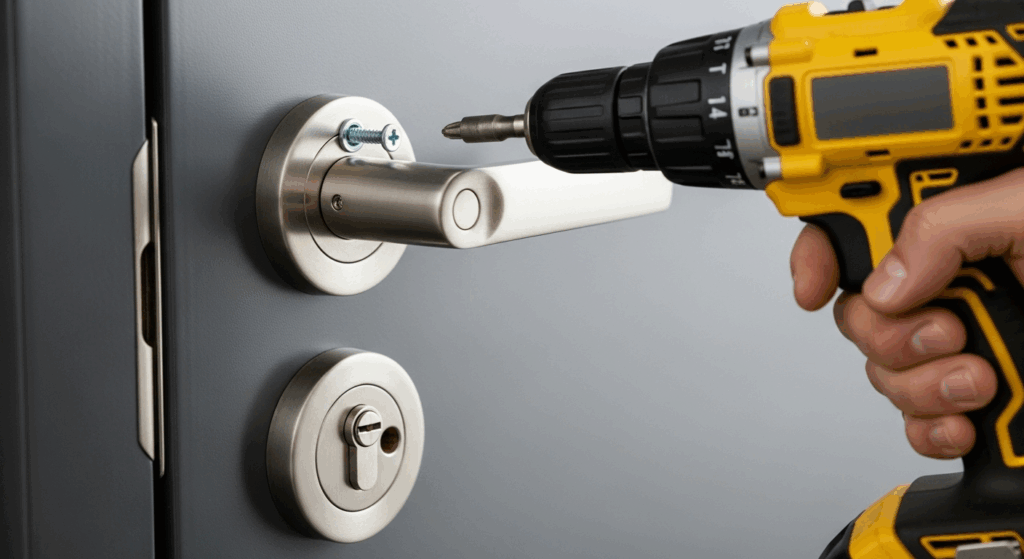How Automotive Locksmiths Handle Emergency Car Lockouts
When keys are locked in the car—or worse, lost entirely—minutes feel like hours. Professional automotive locksmiths are trained to unlock vehicles quickly, safely, and without damage whenever possible. This guide explains how the pros assess a lockout, choose the right tools and techniques for your make and model, verify ownership, and get you rolling again—day or night, rain or shine.
Why Call a Pro Instead of DIY?
Modern vehicles blend mechanical locks with electronic immobilizers, shielded linkages, airbags, and delicate weather seals. A coat hanger or flathead screwdriver can easily scratch paint, tear a membrane, kink a linkage rod, or trigger an airbag module— turning a simple lockout into a body-shop bill or safety issue. Professional automotive locksmiths carry specialized wedges, long-reach tools, air jacks, decoding scopes, and electronic bypass devices, along with the training to use them on specific platforms. The result: faster entry with far less risk.
Another big reason to choose a pro is ownership verification. Reputable locksmiths won’t unlock a vehicle until the customer positively proves they’re entitled to access it. This protects you, your insurer, and the community. It also keeps documentation in order if an insurance claim or roadside assistance program is involved.
The Step-by-Step Emergency Unlocking Workflow
Though every car is different, the professional workflow follows a predictable pattern designed to minimize damage and time on scene.
1) Verify Ownership & Location
Before any tools come out, the tech confirms your identity and vehicle details (VIN, plates, make/model, color). If your ID is in the car, they’ll open under observation and verify immediately afterwards. This step protects everyone involved.
2) Assess Lock Type & Entry Points
The locksmith identifies whether the car uses mechanical rods/cables, shielded linkages, frameless windows, deadlocking, or double-pull handles. They also note proximity of airbags, window frames, and sensors to plan a safe approach.
3) Protect the Vehicle
Paint-safe wedges, protective sleeves, and door guards are placed before any entry attempt. Air wedges are inflated minimally to create a working gap without bending the door or stressing weather seals.
4) Choose the Unlock Technique
Depending on the vehicle, the tech may use a long-reach tool on interior buttons/handles, a lasso tool for pull-type handles, a specialized shield bypass for certain models, or mechanical lock picks in older keyways. Priority is always non-destructive entry.
5) Test Functions & Re-seat Seals
After unlocking, the locksmith checks the handle, central locking, and alarm status, then reseats the weather seal and wipes any marks. If a key was inside, they verify starting the engine and that anti-theft systems are normal.
6) Preventive Advice or On-Site Solutions
If keys are lost or damaged, many pros can cut and program a replacement key/fob on site, create a door-only key as a stopgap, or suggest smart habits to avoid a repeat lockout.
Common Professional Tools & When They’re Used
The “right tool for the right platform” is what separates professional work from guesswork. Here are the usual suspects and their roles.
Air Wedges & Soft Wedges
Create a small, controlled gap near the top of the door to insert protective sleeves and long-reach tools. Inflation is kept minimal to avoid bending the door frame or breaking seal adhesion.
Long-Reach Tools
Telescoping rods with interchangeable tips press unlock buttons, pull handles, or manipulate interior levers. Tip choice is matched to the target (soft tip for buttons, hook for handles).
Shielded Bypass Tools
Some vehicles hide lock rods behind shields. Specialized bypass tools follow a mapped path to trigger the latch without catching on airbags or tearing vapor barriers.
Mechanical Picks for Door Locks
Older vehicles and certain utility models still use traditional keyways. With authorization, a locksmith can pick the door cylinder to the “unlocked” position—often cleaner than prying at the door.
Lasso / Loop Tools
For vertical post locks or pull-type handles, a soft loop tightens around the target to lift or pull without marring surfaces.
Non-Airbag Zones & Sensor Awareness
Pros train on airbag module locations, door-mounted side airbags, and pinch sensors. They avoid those zones, preventing accidental deployments or system faults.
How Methods Vary by Vehicle Type
Not all cars unlock alike. Platform design, lock geometry, and electronics dictate technique. Here’s how locksmiths adapt.
Sedans & Hatchbacks
Most allow safe use of an air wedge at the top rear corner and a long-reach to the unlock button or handle. Double-pull handles and “child lock” quirks are noted to avoid re-locking during exit.
SUVs & Crossovers
Taller beltlines and thicker weather seals call for longer tools and careful wedge placement. Rear hatch buttons may provide an alternate entry if powered and accessible from the interior.
Trucks & Vans
Larger door gaps can be tempting—but locksmiths still use minimal inflation to prevent wind noise or water leaks later. Commercial vans often have shielded rods; bypass techniques are common.
Luxury & Frameless Glass Doors
Coupes with frameless glass require extra care to avoid glass edge stress. Many luxury models use deadlocking; the tech may target interior handles in a specific sequence to avoid re-lock cycles.
Classics & Older Models
Mechanical lock picking or a through-the-gasket button press can be cleaner than prying. Rubber seals on classics are brittle; protection pads and minimal manipulation are essential.
EVs & Smart Access Vehicles
Many EVs rely on key cards, phones, or hidden mechanical backups. Locksmiths know where emergency 12V jump points and manual releases are and how to wake the vehicle without damaging electronics.
What If the Keys Are Lost—Not Just Locked Inside?
Emergency unlocks restore access, but lost keys raise a second challenge: starting the engine. Modern vehicles use immobilizer systems that require a transponder chip or proximity fob. Many automotive locksmiths can cut a mechanical key and program a transponder or smart fob on site using diagnostic tools, PIN code retrieval (when authorized), or EEPROM work on older models. For proximity systems, the tech pairs a new fob to the car and tests remote functions—lock/unlock, trunk, and remote start (if equipped).
In some cases (e.g., theft concerns or unknown key exposure), the safer play is to erase lost keys from the vehicle memory and pair only the new ones. This prevents a found or stolen fob from working later. The locksmith will advise on costs, time, and whether your vehicle supports on-site programming or requires a dealer visit.
Safety, Legal Verification, and Pricing Clarity
Emergency scenes are stressful. Straightforward policies keep things calm and fair.
Ownership Verification
A driver’s license and registration are standard. If documents are inside, the tech opens under supervision and verifies before releasing the vehicle.
Upfront Quotes
Reputable providers quote a clear price range based on vehicle, distance, and time of day, and confirm before work begins—no surprise add-ons.
Scene Safety
On road shoulders or parking lots at night, locksmiths position their vehicle for visibility, use beacons, and may request you move to a safer area if the car is unlocked but not drivable.
Work Notes & Aftercare
Many pros log the method used and note any pre-existing damage. You’ll get simple care tips—like checking for wind noise and reporting any seal issues for quick adjustment.
Typical Emergency Lockout Scenarios & Solutions
Lockouts happen everywhere: grocery lots, daycare drop-offs, job sites, beach parking, late-night gas stations. Here’s how pros handle them.
Keys on the Front Seat, Engine Off
Quick wedge + long-reach to the unlock button or handle. Verify alarm status to avoid honking/flash panic. Total time is typically short.
Keys in Trunk
Many vehicles prevent trunk release when locked; the tech opens the cabin first, then uses interior trunk release. Some models require a rear seat pass-through approach.
Pet or Child Inside
This is a true emergency. The fastest, safest entry is prioritized—often multiple wedges and a direct handle pull. If heat risk is extreme, break glass under guidance; safety always outweighs hardware.
Cold Weather Freeze
Frozen seals or cylinders get a gentle warm-up and de-icer; prying a frozen door can tear seals. Lubrication advice follows to prevent repeats.
Luxury Alarm Spiral
Some models re-lock after a partial unlock. The locksmith times handle pulls or targets specific interior buttons to avoid alarm cascades and battery drain.
Lost Proximity Fob
After entry, the tech programs a new fob (when supported), deletes the lost one, and provides a physical blade key for door backup.
Simple Habits to Avoid Future Lockouts
A few easy changes cut lockout risk dramatically—no special tech required.
Keep a Door-Only Spare
Ask a locksmith for a “non-start” mechanical key that only unlocks doors. Store it in a wallet or coded lockbox; it won’t start the car if lost.
Battery & App Hygiene
Replace fob batteries annually and verify app access before trips. Pair a second device for remote unlock if your model supports it.
Phone as Key? Plan a Backup
If your vehicle uses phone-as-key, carry a credit-card-style backup key or hidden mechanical blade for the driver’s door.
Lube Cylinders
Even if you never use the door key, keep the cylinder alive with periodic dry-film lube so it’s there for emergencies.
Answers to Common Emergency Car Lockout Questions
Quick clarity for stressful moments.
Will unlocking damage my car?
How long does it take?
Can you make a new key if mine is lost?
What proof do you need?
Will my alarm go off?
What Sets Professional Automotive Locksmiths Apart
It’s not just tools—it’s training, platform knowledge, and a safety mindset. The combination delivers faster unlocks and fewer headaches later.
Vehicle-Specific Training
Technicians learn safe entry points, shield layouts, and alarm behaviors across brands to avoid guesswork.
Damage-Avoidance Culture
Protective sleeves, minimal wedge inflation, and careful reseating of seals prevent wind noise and leaks.
On-Site Key Services
Cutting, programming, and erasing lost keys reduce downtime—no tow to the dealer in many cases.
Clear Documentation
Ownership verification, itemized invoices, and method notes make insurance and roadside claims easy.
Two Quick Checklists
Save these to your phone so a lockout never spirals.
- During a Lockout Move to a safe spot • Share location and vehicle details • Confirm quote and ETA • Prepare proof of ownership • Keep phone line open • Avoid DIY prying—wait for the pro with the right tools.
- After the Unlock Verify alarm/central lock • Check window/door seals • Test spare or program new fob if lost • Add a door-only spare to your wallet • Update roadside/locksmith contacts.
Locked Out? Get Fast, Careful Help.
A trained automotive locksmith can unlock your vehicle without damage, verify ownership, and, if needed, cut and program a replacement key on the spot. Clear pricing, respectful service, and tested methods—so you can get back on the road with confidence.

